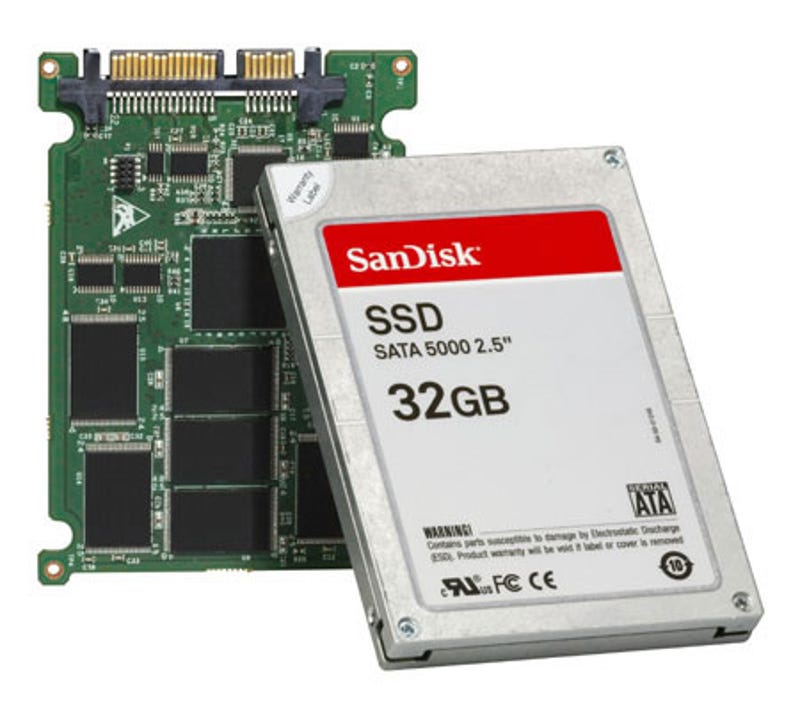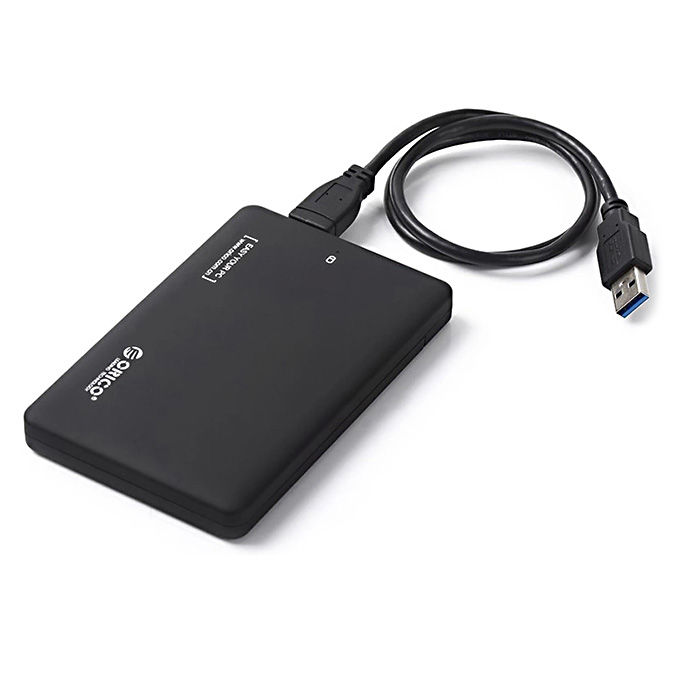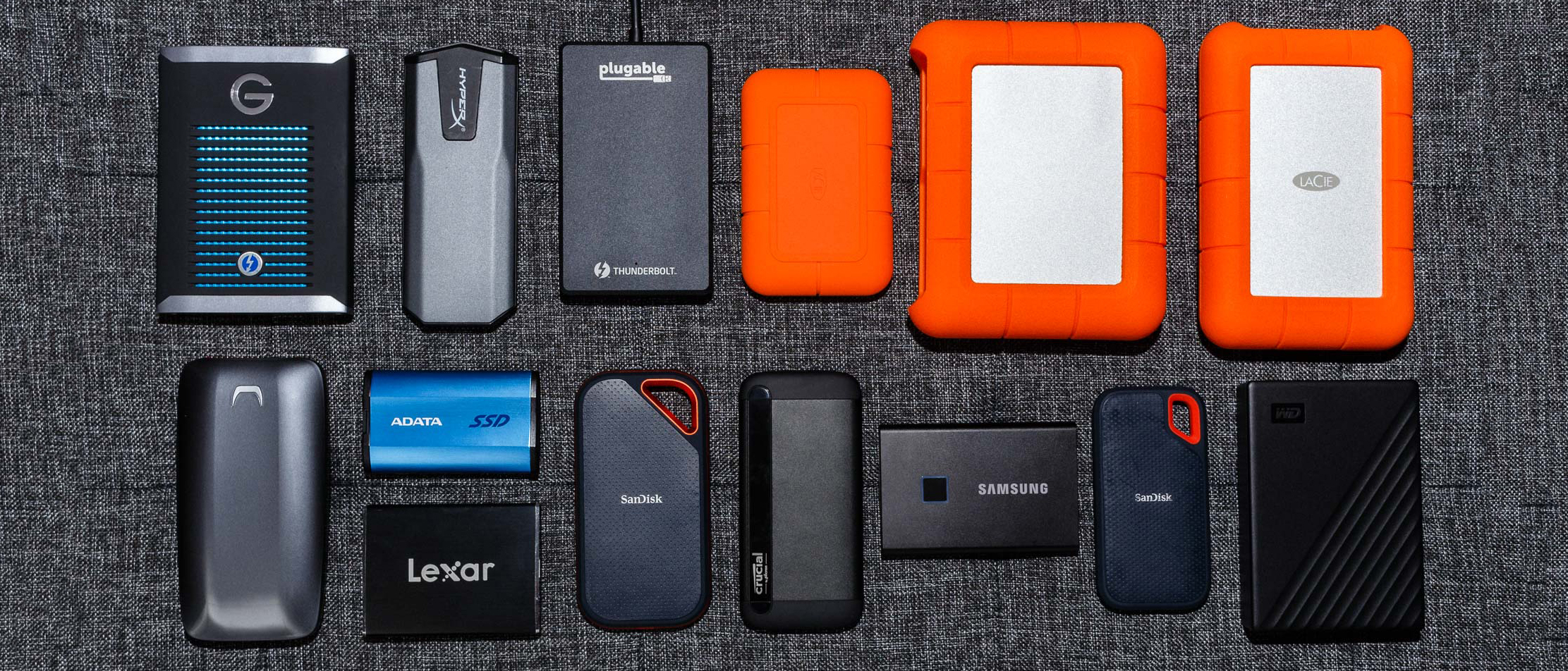How to Choose the Right SSD
If you need speedy local storage for lots of files (say, music or movies you carry around, or all those pics and videos you collect on your phone or camera), you may want to consider a portable solid-state drive (SSD) rather than a portable hard drive.
Once prohibitively expensive, SSDs of all stripes have been falling in price over the past few years, and external SSDs have emerged as alternatives to external hard drives, delivering as much as five times the speed and much greater durability. They have no metal platters to spin up, nor any read/write heads that need to travel to a specific point on a platter to find the file you need. And because of their lack of moving parts, portable SSDs are usually more compact, slimmer, and better suited to frequent travel and accidental drops than even the most thoroughly ruggedized hard drives.
Why (and Why Not) SSDs?
Unlike a hard drive, which stores data on spinning platters accessed by a moving magnetic head, a solid-state drive uses a collection of "persistent" flash memory cells to save data. These are similar to the silicon that makes up a computer's RAM, but they retain your data when electrical power is cut off.


Since hard drives are mechanical devices that use mature technology, you can get relatively huge amounts of storage capacity for the money. But the same tech that makes hard drives a tantalizing value becomes their biggest liability when used on the go. If you drop the drive, you could damage the interior mechanism and make your data inaccessible. By contrast, if you jolt an SSD while you're reading or writing data, there is no risk that your files will become corrupted and unreadable.
And, again, hard drives are slower because they have to physically access your data. Just how much faster is it to read data from flash cells than from particular points on spinning platters? Typical throughput for consumer hard drives is in the range of 100MBps to 200MBps. (One factor is spin rate—among external drives, 5,400rpm units are more common and more affordable than 7,200rpm.)
Our typical benchmark-test results for even run-of-the-mill external SSDs show speeds in excess of 400MBps. Practically speaking, this means you can move gigabytes of data (say, a 4GB feature film, or a year's worth of family photos) to your external SSD in seseconds rather than the minutes it would take with an external hard drive.

Still, you do pay for that speed and durability. Want a 2TB portable hard drive? You can find one from major brands such as Seagate and Western Digital for as little as $60. A 2TB external SSD, on the other hand, will run you about $300. That's not a typo—you'll pay almost five times as much for the same amount of storage. If speed, resilience, and portability are critical to you, all that extra money is probably worth it. If they're not, proceed with care. When considering whether to buy an external SSD, make sure you know what you're getting yourself—and your bank account—into.
External SSDs are now readily available and cheaper than they were a few years ago, but they'll probably never be a complete replacement for hard drives. Physically larger external drives designed to stay on your desk or in a server closet still mostly use 3.5-inch platter drives inside, taking advantage of their higher capacities and lower prices compared with SSDs.
Inside and Out: Understanding External SSD Interfaces
External solid-state drives are, essentially, internal SSDs (the same kind that power laptops or live inside desktops) with an outer shell. As a result, external drives use one of two internal "bus types" that, in part, dictate their peak speed: Serial ATA (SATA), or PCI Express (PCIe). The latter is usually associated these days with Non-Volatile Memory Express (NVMe), a protocol that is optimized for the characteristics of SSDs and speeds up data transfers.

SATA-based drives tend to be a little cheaper; they're also slower, but just fine for most users' everyday applications. SATA-based SSDs typically top out at around 500MBps for peak read and write speeds, just a bit below the ceiling of the USB 3.0 interface. (Much more about that in a moment.) However, if you're going to be transferring large files such as videos often, you may well want to spring for a PCIe/NVMe-based external SSD. That also ties in with the port you'll plug your SSD into.
Sellers of portable SSDs don't always indicate if the drive is SATA- or PCIe-based. However, checking the specs can be a giveaway. If the drive tops out at sequential read and write speeds between 400MBps and 550MBps, it's very likely SATA-based. Speeds of 800MBps or higher indicate a PCIe-based drive.
SSD and USB: So Many Subtleties!
Arguably more important than the type of storage mechanism inside an external SSD is how it connects to your PC or Mac. Almost all external SSDs today plug into either some flavor of USB port or a Thunderbolt 3 port.

Alas, there are enough different flavors of USB to make your head spin—made worse by the confusing nomenclature surrounding USB these days. For example, today's USB 3.2 standard is for all intents and purposes identical to USB 3.1, simply renamed. (It gets better: The forthcoming USB 4 will absorb Thunderbolt 3.) That said, you'll still see older USB terminology your PC or Mac and on many SSDs, so you need to know what term correlates to what.
To begin with, you can forget about USB 2.0, whose theoretical bandwidth of 60 megabytes per second (60MBps) is a bottleneck even for a platter drive. (These ports still exist on desktops and laptops, but you won't want to use one with any portable drive if you can help it, and all USB-interface external SSDs will support some flavor of USB 3.) The most commonly used port for external drives of all stripes is USB 3.0, which offers a theoretical peak bandwidth of 640MBps. Until recently, most SSDs' real-world transfer speeds topped out somewhere in the range of 450MBps or below, so these ports were fine.
In addition to 640MBps, you'll also see USB 3.0's theoretical data rate described as 5Gbps. (That's gigabits, not gigabytes, per second.) You also may see this interface dubbed USB 3.1 Gen 1 or SuperSpeed USB 5Gbps (in practice, all three are the same thing), to differentiate it from USB 3.1 Gen 2 or SuperSpeed USB 10Gbps, which raises the ceiling to (you guessed it!) 10Gbps. USB 3.1 Gen 2 is the latest version widely available in consumer external SSDs at this writing. PCIe external SSDs can take advantage of the extra 5Gbps of bandwidth, but you need to have a USB port that supports the spec to see the extra speed benefit.
In 2019, the USB Implementers' Forum announced that the USB 3.1 flavors were being rebranded as USB 3.2. With that change, you'll want to know these four modes: 5Gbps (USB 3.2 Gen 1), 10Gbps (USB 3.2 Gen 2x1, and Gen 1x2, the former achieving the 10Gbps speed on one "lane," the latter via two 5Gbps lanes), and 20Gbps (USB 3.2 Gen 2x2, aka SuperSpeed USB 20Gbps). All are backward-compatible with USB 3.0 ports; performance will just bounce down to the slower of the two (the drive's supported spec, or that of the system-side port).
You won't see many USB 3.2 Gen 2x2-capable ports on PCs so far (some late-model high-end desktop motherboards have one), but look to that new USB spec to matter more as the 2020s move on.
Really, all this calls for a little chart to keep it straight...

As you can see, some USB specs are tied to certain system-side physical USB connectors; we'll get into that in a moment.
...and Then There's Thunderbolt 3
Thunderbolt 3 offers a blazing top bandwidth of 40Gbps. Compatible ports are found on all late-model Macs and, increasingly, some upscale Windows laptops. Those ports are actually USB Type-C connectors with the Thunderbolt support layered on top. However, Thunderbolt 3 SSDs are not backward-compatible with USB Type-C ports that only support USB transfers. The port has to specifically support Thunderbolt 3; look for the little lightning bolt on port and cable connector...

Thunderbolt 3 is the least-common external SSD interface, and SSDs that use it are often geared toward Mac users. You'll find Thunderbolt 3 on a resolutely speed-focused drives, such as the Samsung Portable SSD X5 and on some desktop-style drives that may contain multiple SSDs in a RAID format.
Most workaday SSDs don't come close to saturating this interface, so there's no point in paying a premium for a Thunderbolt 3 drive unless you specifically need the speed. You can use a Type-C USB drive on a Thunderbolt 3 port, so you're not bound to buying a Thunderbolt 3 drive on a PC with only those ports, such as a Mac.
The Last Interface Wrinkle: The Physical USB Port
Got interface fatigue yet? Alas, that's not the last thing to consider around USB and Thunderbolt 3!
System-side physical USB ports these days take the form of USB Type-A (the familiar, older rectangular kind) and USB Type-C (smaller and roughly oval). This physical type is not necessarily an indicator of which specific USB transfer-rate spec the port supports. But you need to make sure you can plug in what you get.

Many SSDs come with cables for both kinds (Type-A and Type-C) at the computer end, or one cable plus an adapter. Two full cables is generally best, as adapters can be clunky or easy to lose. You'll want to match what comes in the box with which specific ports your PC has (and has free). You'll also want to match specs; there may not be much point in spending extra, for example, for a 10Gbps USB 3.2 Gen 2 SSD if you only have 5Gbps-capable ports.
External SSD Buying Basics
Here are three key things to look out for when shopping for an external SSD:
COST PER GIGABYTE. The way to calculate relative value on drives like these is to perform some simple math and figure the cost per gigabyte based on the price of a given drive on the day you're shopping. Because SSD pricing fluctuates all the time, relative value does, too.
Generally, the higher a drive's capacity, the cheaper it will be per gigabyte. But that's not always true; sometimes the very highest-capacity drives come at a per-gigabyte price premium. The basement for budget external SSDs at this writing was about 18 cents per gigabyte, mostly from second- or third-tier vendors. Calculate your bottom-line price when comparing a host of drives.
RUGGEDIZATION. The degree of ruggedness does vary from drive to drive, with drives like the ADATA SE800 leading the field at the moment among mainstream-price external SSDs. IP68 certification is a good spec to look for if you're serious about waterproof and dustproof drives.
Some models, though, like a few from Apricorn's Fortress series, combine major ruggedness with physical and electrical security; it's almost impossible to crack open those drives to get at the PCBs inside without destroying them.
CARRY WEIGHT. Most SSDs weigh a negligible couple of ounces. I like the carabiner retention loop of SanDisk's Extreme family of drives, as many of these drives are small and light enough that losing them is an easy and expensive mistake.
Should You Make Your Own Portable SSD?
If none of the drives we've selected for this roundup sounds appealing to you (or you already own an internal SSD that's hanging around the house or office), there's one more option available: SSD enclosures. These are plastic or metal housings into which you can put your own SATA 2.5-inch or M.2 solid-state drive to take with you on the go.
Enclosures come in 2.5-inch form factors (into which you would put a 2.5-inch SATA SSD) or M.2 ones. The stick-style M.2 SSD is much smaller and lighter, but know that M.2 drives themselves come in both SATA and PCIe bus flavors. You need to be sure your enclosure supports the kind of M.2 drive you're putting in it.
Also, just because you put a PCIe NVMe drive in an enclosure doesn't mean you should magically expect it to go any faster than a standard external SSD. Any drive placed in an enclosure is still subject to the peak USB speed supported by the enclosure electronics and by the USB protocol supported by the port you plug it into.
Though there are exceptions, most enclosures are not as durable or rugged as major-maker portable SSDs are. This can be a drawback for those who take their SSDs into dangerous environments (think wildlife photographers or first responders), so be sure that before you go this route, you know what your drive will be exposed to. Your data could be at greater risk for corruption than it would be in an SSD purpose-built to withstand the elements.
So, Which External SSD Should I Buy?
Our best SSD picks vary widely in features and price, but all should all deliver plenty of speed and peace of mind if that's what you want from your portable storage. Don't need (or don't want to spring for) an SSD? Then check out our roundup of the best external hard drives. If you're building or upgrading your desktop or laptop, read about how to buy the best M.2 SSDs, as well as the best SSDs for upgrading your laptop.


1 Comments
good content
ReplyDelete